
- Home
- Travel Packages
- Top Destination
-
Travel Attraction
By Category
Top Attraction

- Travel Agents
- Car Rentals
- Hotels
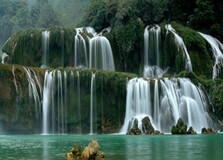
Thác Bạc, also known as the Silver Waterfall, is one of the most stunning natural attractions in Lao Cai Province, near Sapa in northern Vietnam. Cascading from a height of over 200 meters, the waterfall gets its name from the silvery appearance created by its white foamy water as it tumbles down the rocks. Nestled in the Hoang Lien Son mountain range, Thác Bạc is surrounded by lush forests and rugged mountain landscapes, making it a must-visit destination for nature lovers, photographers, and adventurers. How to Reach Thac Bac, Lao Cai Thác Bạc is located approximately 12 kilometers northwest of Sapa Town, on the way to the famous O Quy Ho Pass. From Hanoi: Take an overnight train or bus to Lao Cai City (about 8 hours), followed by a 1-hour drive to Sapa. From Sapa, Thác Bạc is a short ride away by motorbike or taxi. From Sapa: Rent a motorbike, hire a taxi, or join a local tour to reach the waterfall. The road is well-paved and scenic, passing through misty mountains and pine forests. By Tour: Many guided tours from Sapa include Thác Bạc as part of a day trip to nearby attractions like Love Waterfall and Tram Ton Pass. Weather at Thac Bac, Lao Cai Due to its elevation (over 1,800 meters above sea level), Thác Bạc enjoys a cool mountain climate throughout the year. Spring (March–May): Pleasant weather with blooming flowers and clear skies—ideal for photography and sightseeing. Summer (June–August): Lush green surroundings and a strong waterfall flow due to seasonal rains. Autumn (September–November): Mild temperatures and golden rice fields nearby offer great views. Winter (December–February): Cold and often foggy, sometimes with frost or light snow. Bring warm clothes. Timings for Visiting Thac Bac Thác Bạc is open daily, and the best time to visit is during the day when visibility is good and the falls are most impressive. Opening Hours: 7:00 AM – 5:00 PM Best Time of Day: Morning or early afternoon, when the light enhances the silvery cascade Best Season: From April to September when the water volume is highest and the scenery lush Why Famous for Thac Bac, Lao Cai? Thác Bạc is famous for its dramatic appearance, natural setting, and accessibility from Sapa. It is a favorite among tourists for its: Spectacular height and thunderous roar Silvery water that gives the falls its poetic name Easy access and panoramic mountain views from the surrounding area Perfect combination with other nearby natural attractions Great spot for relaxing, taking photos, and enjoying fresh mountain air Entry and Visit Details about Thac Bac, Lao Cai Entrance Fee: Around 20,000 VND per person Parking: Available near the entrance for cars and motorbikes Hiking Path: Paved steps lead up to the viewing platform; moderate fitness level required Facilities: Local shops, small cafés, and souvenir stalls nearby Time Needed: 1 to 1.5 hours to explore and enjoy the waterfall History and Architecture of Thac Bac Thác Bạc is a natural waterfall, but its access infrastructure reflects thoughtful design for eco-tourism. A stairway system and railings allow visitors to climb safely to the viewing platform, where they can see the full drop of the falls. While there is no ancient architecture associated with the site, the area around Thác Bạc is rich in Hmong and Dao cultural heritage. Some of the nearby homes and stalls reflect traditional building styles, using wood and stone adapted to highland climates. Things to Do at Thac Bac Hike to the Viewing Platform: Climb the steps for a closer look at the waterfall and take in panoramic views of the mountains. Photography: The waterfall, surrounding forests, and nearby roads provide stunning photography opportunities. Explore Nearby Attractions: Combine your visit with Love Waterfall, Tram Ton Pass, or O Quy Ho Pass. Souvenir Shopping: Pick up local crafts, handmade scarves, and herbal teas from ethnic minority stalls. Relax with Local Food: Enjoy grilled corn, chestnuts, and other snacks from roadside vendors. Facts about Thac Bac, Lao Cai Located at an altitude of over 1,800 meters above sea level Water flows down a series of rock ledges over 200 meters high One of the tallest and most accessible waterfalls in Vietnam Named “Silver Waterfall” because of its shimmering white flow Near the peak of Vietnam’s highest mountain pass – O Quy Ho Tips about Thac Bac, Lao Cai Wear Good Footwear: The steps can be wet and slippery—comfortable shoes with good grip are essential. Bring a Jacket: Even in summer, it can be cool and breezy near the waterfall. Start Early: Visit in the morning to avoid crowds and enjoy the best lighting for photos. Combine with Other Sites: Plan a day trip that includes Love Waterfall and Tram Ton Pass for a full mountain experience. Stay Hydrated: The elevation and climb to the top can be tiring—carry water with you. Respect Nature: Avoid littering and stay on marked paths to preserve the natural beauty.
Explore More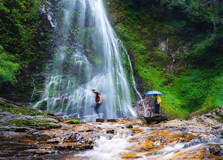
Love Waterfall (Thác Tình Yêu) is one of the most romantic and captivating natural attractions near Sapa, in the Lao Cai Province of northern Vietnam. Set amidst the lush green landscape of the Hoang Lien Son National Park, the waterfall drops from a height of about 100 meters and is surrounded by rich biodiversity and misty forests. Its name originates from a local legend about a fairy who fell in love with a mountain boy at this very location. The waterfall’s tranquil beauty, scenic hiking trail, and mythical backstory make it a popular destination for couples, nature lovers, and hikers alike. How to Reach Love Waterfall, Lao Cai Love Waterfall is located approximately 14 kilometers southwest of Sapa Town, near Tram Ton Pass—the highest mountain pass in Vietnam. From Hanoi: Take a train or sleeper bus to Lao Cai City (about 8 hours), then travel by car or minibus to Sapa (1 hour), and from Sapa, continue about 30 minutes to the Love Waterfall entrance. From Sapa: Rent a motorbike or hire a taxi to reach the entrance gate of Hoang Lien National Park. The road is scenic, winding, and paved. By Tour: Many tour companies in Sapa include Love Waterfall as part of a guided trek or sightseeing package that also includes Silver Waterfall and O Quy Ho Pass. Weather at Love Waterfall, Lao Cai The weather around Love Waterfall is cool and temperate due to the high elevation (over 1,800 meters above sea level). The area experiences four distinct seasons. Spring (March–May): Cool and dry, with blooming rhododendrons and wildflowers along the trail—an ideal time for a visit. Summer (June–August): Warm and lush, but often rainy. The waterfall flows more powerfully during this season. Autumn (September–November): Clear skies, golden foliage, and perfect weather for trekking and photography. Winter (December–February): Cold, with occasional frost or snow. A mystical time to visit but dress warmly. Timings for Visiting Love Waterfall Love Waterfall is open to visitors daily during daylight hours. The best time to visit is in the morning or early afternoon when the light filters beautifully through the forest. Opening Hours: 7:00 AM – 5:00 PM Best Visiting Time: March to May and September to November Recommended Duration: 2 to 3 hours including the trek Why Famous for Love Waterfall, Lao Cai? Love Waterfall is famous not only for its natural beauty but also for its romantic folklore and serene setting. Beautiful 100-meter waterfall set in a pristine forest landscape Part of Hoang Lien National Park, rich in flora and fauna Named after a love story between a fairy and a mountain boy Peaceful hiking trail with wooden bridges and natural streams Perfect for couples and photographers seeking romantic scenery Entry and Visit Details about Love Waterfall, Lao Cai Entrance Fee: Around 70,000 VND per person (subject to change) Parking: Available near the entrance for motorbikes and cars Hike Distance: About 1.5 kilometers (30–40 minutes) each way through forest trail Facilities: Small stalls selling snacks, drinks, and souvenirs near the gate Local Guides: Available for hire at the entrance if needed History and Architecture of Love Waterfall Although Love Waterfall is a natural formation and does not feature built architecture, the area is steeped in legend. According to local folklore, a fairy from the heavens fell in love with a mountain boy who used to bathe at the base of the waterfall. When forbidden to see him, she returned daily in secret. Eventually, she transformed into a bird to be near him forever. This romantic legend has given the site its symbolic name and continues to inspire visitors. Infrastructure such as wooden bridges, railings, and signs along the trail has been designed with eco-friendliness in mind, blending into the natural environment without disturbing the park’s ecology. Things to Do at Love Waterfall Scenic Trekking: Walk through lush forests, bamboo groves, and flower-lined paths to reach the waterfall. Photography: Capture mesmerizing views of the cascading water, forest trails, and scenic bridges. Picnicking: Relax by the stream with a light meal while enjoying the sound of rushing water. Nature Observation: Spot butterflies, birds, and rare plants in the biodiversity-rich park. Romantic Strolls: Perfect spot for couples looking for a tranquil and symbolic destination. Facts about Love Waterfall, Lao Cai Height: Approximately 100 meters tall Location: Hoang Lien National Park, near Tram Ton Pass Distance from Sapa: About 14 kilometers One of the most romantic landmarks in northern Vietnam Surrounded by rhododendron flowers and pine forests Tips about Love Waterfall, Lao Cai Wear Comfortable Footwear: Hiking shoes or good sandals are necessary for the forest path. Bring Water: Stay hydrated, especially during the summer trek. Dress in Layers: Temperatures can fluctuate, especially in the morning or late afternoon. Start Early: Morning visits ensure fewer crowds and softer lighting for photography. Travel in Groups: While the trail is safe, it’s more enjoyable with friends or a guide. Respect the Environment: Do not litter and stay on designated trails to protect the forest.
Explore More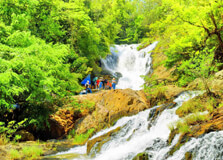
Datanla Waterfall is one of the most popular and accessible natural attractions in Da Lat, Vietnam. Nestled in the pine forests just a few kilometers from the city center, the waterfall is known for its scenic beauty, fresh atmosphere, and thrilling adventure activities. The waterfall cascades down rocky steps, creating several small falls and pools that make it a perfect destination for nature lovers and outdoor enthusiasts. Datanla Waterfall offers a unique blend of natural charm and exciting experiences, making it a must-visit location in Da Lat. How to Reach Datanla Waterfall, Da Lat Datanla Waterfall is located about 5 kilometers from Da Lat city center and is very easy to reach: By Taxi: Taxis are readily available in Da Lat and can take you directly to the entrance of the waterfall within 10–15 minutes. By Motorbike: Renting a motorbike is a flexible and budget-friendly option. The road is well-maintained and signposted. By Tour Bus or Shuttle: Many local tour companies offer half-day or full-day trips that include Datanla Waterfall as one of the stops. The waterfall is situated on the Prenn Pass, which is a scenic drive filled with beautiful pine forests and valley views. Weather at Datanla Waterfall, Da Lat The weather at Datanla Waterfall is similar to the rest of Da Lat – cool and mild all year round: Dry Season (November to April): The best time to visit, with clear skies and comfortable temperatures for hiking and outdoor activities. Rainy Season (May to October): The waterfall is fuller and more dramatic, but trails may be slippery. Mornings are usually drier than afternoons. Temperatures typically range between 15°C and 25°C, with occasional mist that adds to the waterfall’s mystical ambiance. Timing and Entry Details Datanla Waterfall is open daily from 7:30 AM to 5:00 PM. Entry Fee: Adults: 50,000 VND Children: 25,000 VND Additional charges apply for adventure activities and the alpine coaster: Alpine Coaster: From 100,000 VND (round trip) Rappelling and canyoning: Tour packages start from 1,000,000 VND Why Datanla Waterfall is Famous Datanla Waterfall is famous for its accessibility, natural beauty, and adventure activities. Unlike other waterfalls that require long hikes, Datanla can be reached via a fun and thrilling alpine coaster that winds through the forest. The waterfall is also popular for activities like canyoning, abseiling, zip-lining, and rafting. Additionally, the name "Datanla" means "water under the leaves" in the local K’ho language, referring to how the falls were hidden beneath thick foliage and only discovered later. The site also has connections to local legends involving fairies and brave warriors, adding a mystical aura to the experience. History and Architecture While Datanla Waterfall is primarily a natural site, it holds cultural and historical significance. The area was once a hiding place for the local ethnic groups during times of conflict. Over the years, it has been developed with eco-tourism in mind, ensuring that the infrastructure supports tourism while preserving the natural landscape. The infrastructure around the waterfall includes well-maintained walking paths, safety railings, bridges, and viewing platforms. The alpine coaster, built to international safety standards, adds a modern and fun way to experience the forest and the falls. Things to Do at Datanla Waterfall There’s more to do at Datanla Waterfall than just admire the view. It’s a hub for outdoor adventure and scenic exploration: Alpine Coaster Ride: Ride down to the base of the waterfall through a forested trail on a self-controlled roller coaster. It's both thrilling and scenic. Hiking: Several trails lead through pine forests, offering a more traditional way to reach and explore the waterfall area. Canyoning and Rappelling: Guided adventure tours are available for adrenaline seekers, including abseiling down the waterfall. Zip-lining: Some tour operators offer zip-lining adventures through the forest canopy. Swimming: Although not all pools are safe for swimming, some calmer spots near the falls can be enjoyed under supervision. Photography: With the dramatic backdrop of cascading water, lush greenery, and mist, it’s an excellent spot for nature and travel photography. Interesting Facts about Datanla Waterfall Datanla is considered one of the easiest waterfalls to reach in Da Lat, thanks to its close proximity to the city. The alpine coaster is the first of its kind in Vietnam and remains a top attraction. Legends say that Datanla was a meeting place for fairies and that the water has mystical healing properties. The waterfall is approximately 20 meters high and cascades into multiple smaller falls and natural rock pools. It’s a favorite spot for local school trips and international adventure travelers alike. Tips for Visiting Datanla Waterfall, Da Lat Wear non-slip shoes or hiking sandals, as the area around the waterfall can be wet and slippery. Visit early in the morning to avoid crowds, especially during weekends and holidays. Carry a waterproof jacket or poncho during the rainy season, as sudden showers are common. If participating in adventure sports, choose licensed operators and always follow safety instructions. Keep your belongings secure during the coaster ride—use backpacks or zippered bags. Stay on marked paths and avoid climbing on rocks near the edge of the falls. Bring a camera, but also take time to enjoy the peaceful sounds and sights of nature without distractions.
Explore More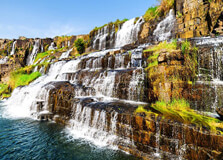
Pongour Waterfall, often referred to as the “most majestic waterfall of the Central Highlands,” is one of the most beautiful natural sites near Da Lat, Vietnam. Located in Duc Trong District, about 45 kilometers south of Da Lat city center, this magnificent waterfall cascades over multiple rock terraces, forming a layered curtain of white water surrounded by lush greenery and peaceful surroundings. Its width stretches over 100 meters, and it drops more than 40 meters, making it one of the largest and most spectacular waterfalls in the region. How to Reach Pongour Waterfall, Da Lat Getting to Pongour Waterfall from Da Lat is a scenic and rewarding journey: By Motorbike: One of the best ways to reach Pongour is by motorbike. The route follows National Highway 20 and takes around 1.5 hours. This allows visitors to enjoy the natural scenery, local life, and small towns along the way. By Car or Taxi: Private taxis and cars can be hired from Da Lat. The drive is comfortable and suitable for groups or families. It usually takes about 1 to 1.5 hours to reach the waterfall. By Tour Package: Several travel agencies in Da Lat offer guided day tours to Pongour Waterfall, often including other attractions in the itinerary like Elephant Waterfall or Linh An Pagoda. Weather at Pongour Waterfall, Da Lat The area around Pongour Waterfall has a mild and pleasant climate, similar to Da Lat but slightly warmer due to lower elevation. Dry Season (November to April): The best time to visit. The skies are usually clear, and the weather is suitable for walking, hiking, and picnicking. Rainy Season (May to October): The waterfall becomes more powerful and dramatic. However, paths may be slippery, and care should be taken when walking near wet rocks. Average temperatures range from 18°C to 28°C depending on the season, with cooler temperatures in the early morning and evening. Timing and Entry Details Pongour Waterfall is open daily from 7:00 AM to 5:30 PM. It is advisable to visit in the morning to avoid crowds and enjoy the peaceful ambiance. Entry Fee: Adults: 20,000 VND Children: 10,000 VND Additional small fees may apply for parking or using services like food stalls and rest areas. Visitors are allowed to walk down a well-maintained trail to the base of the waterfall. Why Pongour Waterfall is Famous Pongour Waterfall is celebrated for its unique multi-tiered structure and wide curtain-like flow. It is one of the rare waterfalls in Vietnam that flows over large, naturally formed basalt rock steps, creating a striking visual effect. Its tranquil surroundings and untouched environment make it a favorite spot for both nature enthusiasts and photographers. The site is also linked to a local legend about a K’ho ethnic female chief named Kanai, who was said to possess spiritual powers and was beloved by her people. According to the story, when she died, the land transformed into this beautiful waterfall, and her loyal animals became the rock formations around it. This myth adds cultural and spiritual significance to the location. History and Architecture Pongour is a natural geological wonder shaped by volcanic activity over millions of years. The unique basalt rock formations seen at the site are a result of ancient lava flows that cooled and cracked into layers. Over time, water carved its way through the rocks, forming the terraces seen today. Unlike many modern tourist sites, Pongour Waterfall has minimal artificial construction. Instead, the focus is on preserving its raw, natural beauty. The entrance area features simple bamboo huts, bridges, and footpaths that blend into the landscape. A wide stone staircase leads visitors to the base of the waterfall, and there are shaded picnic areas for resting. Things to Do at Pongour Waterfall There is more to do at Pongour Waterfall than just admire the view. Visitors can enjoy a range of activities that blend relaxation with exploration: Nature Walks: Stroll through the green trails and pathways that lead to the waterfall. The route is lined with trees and flowering plants. Photography: The waterfall’s multi-level cascade and surrounding rocks provide a stunning backdrop for landscape and portrait photography. Picnicking: The area around the waterfall is perfect for a relaxing picnic with friends or family. There are designated areas to sit and enjoy a meal. Swimming: In the dry season, shallow pools at the base of the falls are sometimes calm enough for wading or a refreshing dip. Camping: Pongour is a popular camping spot during certain holidays and festivals. Local vendors sometimes rent tents or provide firewood for overnight stays. Interesting Facts about Pongour Waterfall Pongour is often called the “Seven-Step Waterfall” due to its layered appearance across seven basalt rock tiers. The falls span over 100 meters wide and fall from a height of 40 meters. It is one of the few waterfalls in Vietnam where visitors can get close to the base safely during the dry season. The waterfall is surrounded by thick forest, home to many native birds and plant species. Pongour Festival is held annually on the full moon of the first lunar month to honor the legendary Kanai and celebrate local ethnic culture. Tips for Visiting Pongour Waterfall, Da Lat Wear comfortable walking shoes as the path to the waterfall involves stairs and uneven ground. Bring drinking water, sun protection, and insect repellent, especially if you plan to spend several hours there. Visit in the morning for the best lighting for photography and cooler temperatures. Do not climb on wet rocks or venture too close to fast-moving water, especially during the rainy season. Respect the environment—avoid littering and do not disturb local wildlife. If visiting during the Pongour Festival, expect crowds and a vibrant cultural atmosphere with music, food, and traditional performances. Combine your visit with other nearby attractions like Elephant Waterfall or Linh An Pagoda for a full-day nature excursion from Da Lat.
Explore More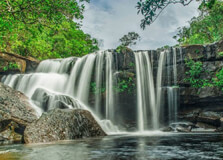
Suoi Tranh Waterfall is one of the most stunning natural attractions on Phu Quoc Island, located in the central part of the island. Known for its peaceful ambiance, lush greenery, and crystal-clear waters, the waterfall is a perfect spot for nature lovers and those looking to escape the island’s beaches. Surrounded by tropical forests, the waterfall is a refreshing and tranquil retreat that offers visitors a chance to relax, swim, or simply enjoy the beauty of the surrounding landscape. It’s a must-visit location for anyone visiting Phu Quoc Island. How to Reach Suoi Tranh Waterfall, Phu Quoc Island Reaching Suoi Tranh Waterfall is relatively easy, and it is located approximately 10 kilometers from Duong Dong Town, the main town on Phu Quoc Island. The waterfall is accessible by car, taxi, or motorbike. Here’s how you can get there: By Taxi or Car: The most convenient way to reach the waterfall is by taking a taxi or private car from Duong Dong Town. The journey takes about 20 minutes, depending on traffic. Taxis can be easily booked, and most hotels can arrange a car for you. By Motorbike: Renting a motorbike is another great option for exploring Phu Quoc at your own pace. The road leading to Suoi Tranh Waterfall is well-paved, and motorbike rentals are available in Duong Dong Town. By Guided Tour: Many local tour operators on Phu Quoc Island offer guided tours to Suoi Tranh Waterfall. These tours often include visits to other nearby attractions, making it an efficient way to explore the island. Weather at Suoi Tranh Waterfall, Phu Quoc Island Phu Quoc Island has a tropical climate, which means the weather at Suoi Tranh Waterfall is warm and humid year-round, with distinct wet and dry seasons. Dry Season (November to March): This is the best time to visit the waterfall, as the weather is sunny and pleasant, with little to no rainfall. The waterfall's water flow may be reduced in the dry season, but the surrounding scenery is still lush and green. Rainy Season (April to October): The rainy season brings heavy showers and high humidity to Phu Quoc, especially in the afternoon. During this time, the waterfall's flow is at its strongest, and the surrounding forest is particularly vibrant and lush. However, it's important to note that heavy rain can make the trails slippery and less comfortable for hiking. Timing to Visit Suoi Tranh Waterfall, Phu Quoc Island Suoi Tranh Waterfall is open year-round, but the best time to visit is during the dry season (November to March). The waterfall’s surroundings are easy to explore during this time, and the weather is perfect for outdoor activities. However, visitors can still enjoy the waterfall during the rainy season (April to October), especially for those who want to see the waterfall at its full strength after the rains. The waterfall is less crowded in the early morning, making it an ideal time for those looking for a peaceful visit. If you prefer a quieter experience, avoid visiting during the midday when the area can be busier with tourists. Why Famous for Suoi Tranh Waterfall, Phu Quoc Island? Suoi Tranh Waterfall is famous for its natural beauty, tranquil atmosphere, and lush surroundings. Here are the reasons why it is such a popular destination on Phu Quoc Island: Natural Beauty: The waterfall is surrounded by dense tropical forests, making it a perfect spot for nature lovers. The cascading water, cool pools, and verdant landscape offer a peaceful retreat for visitors looking to enjoy nature at its finest. Peaceful Ambiance: Suoi Tranh Waterfall is located away from the more touristy areas of Phu Quoc Island, offering a quieter and more tranquil experience. The gentle sounds of flowing water and the rustling of leaves create a calming atmosphere for visitors. Perfect for Swimming: The waterfall features several natural pools where visitors can take a refreshing swim, especially during the hot months. The clear water and cool temperature make it a relaxing spot to unwind. Photography Opportunities: The waterfall and its surrounding environment provide countless opportunities for stunning photographs. Whether you’re capturing the water flowing over the rocks or the lush greenery of the forest, Suoi Tranh offers a perfect backdrop for nature photography. Entry and Visit Details about Suoi Tranh Waterfall, Phu Quoc Island Suoi Tranh Waterfall is open to the public, and there is no entrance fee to access the waterfall itself. However, visitors may be asked to pay a small fee for parking or to rent local facilities such as chairs or umbrellas. There are also small fees for activities such as swimming or using certain amenities provided by nearby vendors. The waterfall is accessible via a well-maintained trail that winds through the forest, allowing visitors to experience the natural beauty of the area. The path is relatively easy to walk, but it can get slippery, especially during the rainy season, so it is important to wear comfortable, non-slip shoes. There are several small restaurants and cafes near the waterfall where visitors can enjoy a meal or refreshment while taking in the scenic views. History and Architecture of Suoi Tranh Waterfall, Phu Quoc Island Suoi Tranh Waterfall does not have significant historical or architectural landmarks. It is a natural attraction formed by the flow of water from the surrounding mountains. The area around the waterfall has been preserved in its natural state, and the local government has taken steps to maintain its beauty and ecological balance. The waterfall itself is a charming and unspoiled part of Phu Quoc’s natural landscape. There are no large constructions or resorts around the waterfall, which helps retain its authentic charm and unspoiled beauty. This lack of commercialization makes the waterfall a peaceful and serene place to visit. Things to Do at Suoi Tranh Waterfall, Phu Quoc Island While Suoi Tranh Waterfall is primarily a natural attraction, there are several activities visitors can enjoy during their visit: Swimming: The natural pools at the waterfall are perfect for swimming, providing visitors with a refreshing dip in cool water surrounded by nature. Hiking: The path leading to the waterfall offers an easy and scenic hike through the tropical forest. Visitors can enjoy the diverse flora and fauna along the trail. Picnicking: There are spots around the waterfall where visitors can relax and have a picnic while enjoying the tranquil surroundings. Photography: The beauty of Suoi Tranh Waterfall and its lush environment makes it an ideal location for photography. Whether you're snapping pictures of the cascading water or the vibrant greenery, there’s no shortage of photo opportunities. Relaxing: Simply spending time by the waterfall, listening to the sounds of nature, and enjoying the peaceful atmosphere is one of the best things to do here. Facts About Suoi Tranh Waterfall, Phu Quoc Island Suoi Tranh Waterfall is located approximately 10 kilometers from Duong Dong Town, making it easy to access by car or motorbike. The waterfall is surrounded by lush tropical forest, which provides a peaceful and scenic environment for visitors. There is no entrance fee to visit the waterfall, though visitors may be charged for parking or for using some local amenities. Suoi Tranh is one of the more tranquil and less-crowded natural attractions on Phu Quoc Island, offering a quiet retreat away from the busier tourist areas. Tips for Visiting Suoi Tranh Waterfall, Phu Quoc Island Wear Comfortable Shoes: The trail to the waterfall can be slippery, so it’s important to wear sturdy, non-slip shoes. Bring Swimwear: The natural pools are perfect for swimming, so don’t forget to bring your swimwear for a refreshing dip. Protect Yourself from the Sun: While the forest offers some shade, it's still important to bring sunscreen and wear a hat to protect yourself from the sun. Bring Water: There are no shops or restaurants along the trail, so it’s a good idea to bring your own water and snacks. Respect Nature: Keep the environment clean by disposing of waste responsibly and avoiding any damage to the surrounding flora and fauna.
Explore More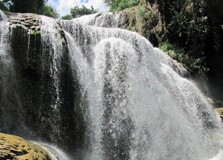
Mo Waterfall, also known as Thác Mơ in Vietnamese, is one of the hidden gems of Yen Bai Province, located in Luc Yen District in northern Vietnam. This stunning natural site is known for its multi-tiered cascades, crystal-clear waters, and lush surroundings. Far from the commercial tourist paths, Mo Waterfall offers a peaceful escape into nature for those who seek serenity, cool mountain air, and scenic beauty. Set amidst ancient forests and rugged rock formations, Mo Waterfall is both a destination for relaxation and a spot of cultural significance for local communities. Its name “Mơ” translates to “Dream,” reflecting the ethereal atmosphere created by the gently falling waters, surrounding mist, and bird songs. Whether you are a nature lover, an adventurer, or a photographer, Mo Waterfall is a destination worth exploring. How to Reach Mo Waterfall, Yen Bai Mo Waterfall is located about 100 kilometers from Yen Bai City and around 200 kilometers from Hanoi. It is situated in Tan Linh Commune, Luc Yen District. By Car or Motorbike from Hanoi: Travel via National Highway 2 or Highway 70 through Tuyen Quang. The journey takes about 5–6 hours. After reaching Luc Yen town, continue for another 15 km to reach the waterfall site. By Bus: You can take a bus from My Dinh Bus Station in Hanoi to Luc Yen town. From there, hire a taxi or motorbike taxi to reach Mo Waterfall. By Train: Take a train from Hanoi to Yen Bai City. From there, you can hire a private car or taxi to Luc Yen and on to the waterfall. Weather at Mo Waterfall, Yen Bai Mo Waterfall experiences a tropical highland climate with cooler temperatures than the lowlands: Spring (March to May): Pleasant weather with blooming wildflowers and lush greenery. Temperatures range from 20°C to 28°C. Summer (June to August): Warm and humid, with occasional rainfall. The waterfall flows at its fullest. Temperatures hover around 25°C to 32°C. Autumn (September to November): Mild and dry, excellent for trekking and sightseeing. Temperatures between 18°C and 26°C. Winter (December to February): Cool to cold, with fog in the early morning. Temperatures can dip below 15°C. Timing and Entry Details Mo Waterfall is open year-round and does not have a formal entry gate. However, some local management groups or nearby households may collect a small fee for upkeep and parking. Opening Hours: Typically from 6:00 AM to 6:00 PM, though there are no strict access restrictions. Entry Fee: Around 20,000–30,000 VND per person (subject to change depending on local policies). Best Time to Visit: Late spring and early autumn when water levels are ideal and the weather is most comfortable. Why Mo Waterfall is Famous Mo Waterfall is well-known for its natural beauty and relaxing ambiance. It is especially popular among local Vietnamese travelers and nature photographers for the following reasons: Multi-Level Cascades: The waterfall consists of several gentle tiers, allowing safe swimming and exploration. Clear Pools: Natural pools at the base of each tier are perfect for soaking or a refreshing dip. Surrounding Forests: The area is rich in biodiversity and ideal for short treks and nature walks. History and Cultural Significance Though there is no grand architectural structure at Mo Waterfall, the area holds cultural value for the local Tay and Dao ethnic communities who live in nearby villages. They believe that the waterfall has spiritual importance, often linked to local legends of natural spirits and fertility. Many local festivals and rituals are tied to the forest and water, especially during the Lunar New Year or the beginning of the farming season. Visitors may occasionally witness traditional ceremonies or music near the area if visiting during festive times. Things to Do at Mo Waterfall, Yen Bai Swimming: Take a dip in the clean, cool natural pools at the base of the falls. Photography: Capture the beauty of flowing water, green surroundings, and wildlife. Picnicking: Enjoy a quiet lunch beside the waterfall in shaded areas. There are some picnic spots near the banks. Trekking: Short forest trails around the waterfall offer scenic views and bird-watching opportunities. Visit Local Villages: Explore nearby ethnic villages to learn about the Tay and Dao cultures, their crafts, and their lifestyle. Interesting Facts about Mo Waterfall Mo Waterfall is one of the least commercialized waterfalls in Yen Bai, making it ideal for eco-tourism. It’s known locally as the “Dream Waterfall” due to its gentle and calming nature. The waterfall's water source comes from the forests of Tan Linh and is considered pure and mineral-rich. Luc Yen district, where the waterfall is located, is also known for gemstone mining and handicrafts. During the rainy season, the waterfall swells dramatically but remains relatively safe due to its layered formation. Tips for Visiting Mo Waterfall, Yen Bai Wear Good Footwear: Some parts of the trail are rocky or slippery, so hiking shoes or sandals with grip are recommended. Bring Food and Water: There are limited shops nearby. It’s best to carry essentials for your trip. Travel with a Local Guide: Helpful if you want to explore deeper forest trails or visit nearby villages. Respect the Environment: Carry out all trash and avoid disturbing wildlife or natural pools. Visit Early: To avoid the midday heat and enjoy the peaceful atmosphere without crowds. Combine with Other Attractions: Consider pairing your visit with a stop in Luc Yen Gem Market or nearby caves for a full-day adventure.
Explore More